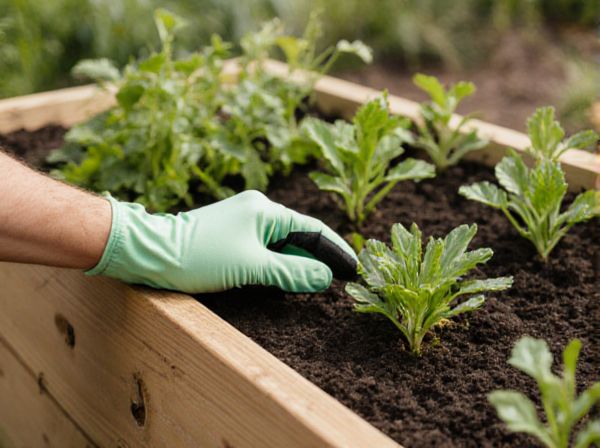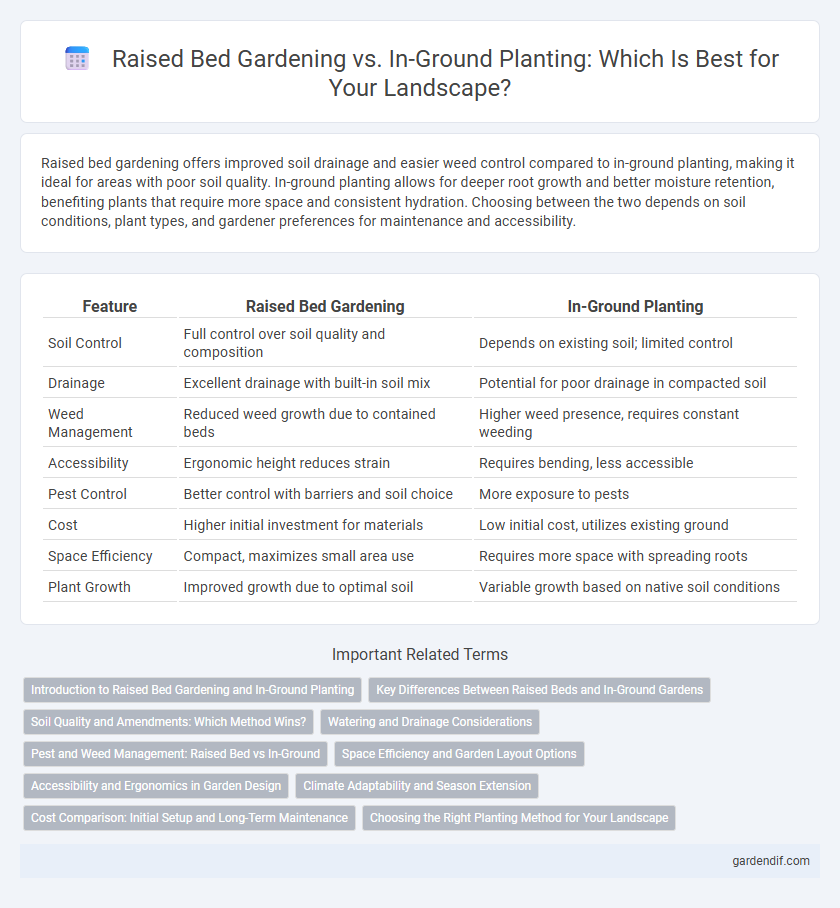
Raised Bed Gardening vs In-Ground Planting Illustration
Raised bed gardening offers improved soil drainage and easier weed control compared to in-ground planting, making it ideal for areas with poor soil quality. In-ground planting allows for deeper root growth and better moisture retention, benefiting plants that require more space and consistent hydration. Choosing between the two depends on soil conditions, plant types, and gardener preferences for maintenance and accessibility.
Table of Comparison
| Feature | Raised Bed Gardening | In-Ground Planting |
|---|---|---|
| Soil Control | Full control over soil quality and composition | Depends on existing soil; limited control |
| Drainage | Excellent drainage with built-in soil mix | Potential for poor drainage in compacted soil |
| Weed Management | Reduced weed growth due to contained beds | Higher weed presence, requires constant weeding |
| Accessibility | Ergonomic height reduces strain | Requires bending, less accessible |
| Pest Control | Better control with barriers and soil choice | More exposure to pests |
| Cost | Higher initial investment for materials | Low initial cost, utilizes existing ground |
| Space Efficiency | Compact, maximizes small area use | Requires more space with spreading roots |
| Plant Growth | Improved growth due to optimal soil | Variable growth based on native soil conditions |
Introduction to Raised Bed Gardening and In-Ground Planting
Raised bed gardening involves cultivating plants in soil contained within elevated frames, enhancing drainage, soil quality, and root growth compared to traditional in-ground planting. In-ground planting places crops directly into the native soil, benefiting from natural soil ecosystems but often facing challenges like poor drainage and soil compaction. Choosing between raised beds and in-ground planting depends on factors such as soil condition, space availability, and gardening goals.
Key Differences Between Raised Beds and In-Ground Gardens
Raised bed gardening offers improved soil drainage, enhanced root growth, and better weed control compared to in-ground planting, which relies on existing soil conditions that may be compacted or nutrient-deficient. Raised beds allow for precise soil amendments and can extend the growing season due to faster soil warming, while in-ground gardens typically provide more space but require more maintenance to prevent soil erosion and pests. Choosing between raised beds and in-ground planting depends on soil quality, space availability, and gardener preference for control over growing conditions.
Soil Quality and Amendments: Which Method Wins?
Raised bed gardening offers superior soil quality control by allowing gardeners to customize soil composition with organic matter, compost, and nutrients, leading to improved drainage and aeration. In-ground planting relies on existing soil conditions, which may require extensive amendments to enhance fertility and structure, often posing challenges in compacted or poor-draining soils. Overall, raised beds provide a more efficient and manageable environment for soil amendments, promoting healthier plant growth and higher yields.
Watering and Drainage Considerations
Raised bed gardening offers superior drainage compared to in-ground planting due to elevated soil levels preventing waterlogging and promoting root aeration. Watering efficiency is enhanced in raised beds as moisture is retained within the contained soil, reducing runoff and evaporation. In contrast, in-ground planting often requires careful irrigation management to avoid poor drainage areas that lead to root rot and water stress.
Pest and Weed Management: Raised Bed vs In-Ground
Raised bed gardening offers superior pest and weed management compared to in-ground planting due to elevated soil levels that reduce weed intrusion and improve drainage, discouraging root rot and pest habitats. The contained environment of raised beds facilitates targeted application of organic mulch and pest barriers, minimizing chemical use and enhancing soil health. In-ground planting often faces higher weed pressure and pests due to direct soil contact and less controlled conditions, requiring more frequent interventions for effective pest and weed control.
Space Efficiency and Garden Layout Options
Raised bed gardening maximizes space efficiency by allowing dense planting and better soil management, making it ideal for small or irregular garden layouts. In-ground planting offers greater flexibility for larger areas but often requires more extensive spacing to prevent competition among plants. Choosing raised beds enhances vertical layering and organized rows, optimizing both plant health and garden aesthetics.
Accessibility and Ergonomics in Garden Design
Raised bed gardening enhances accessibility by elevating soil levels, reducing the need for bending and kneeling, which benefits individuals with mobility challenges or back issues. In-ground planting often requires more physical effort to reach and maintain, potentially causing strain during prolonged gardening activities. Designing gardens with ergonomic principles, such as adjustable heights and clear pathways, improves comfort and inclusivity for a wider range of gardeners.
Climate Adaptability and Season Extension
Raised bed gardening offers superior climate adaptability by improving soil drainage and increasing soil temperature, which extends the growing season compared to in-ground planting. Enhanced soil control allows gardeners to adjust pH and fertility levels more effectively, supporting earlier planting in spring and prolonged harvests into fall. These advantages make raised beds ideal for regions with unpredictable weather patterns and shorter growing seasons.
Cost Comparison: Initial Setup and Long-Term Maintenance
Raised bed gardening often involves higher initial setup costs due to materials like wood, soil, and hardware, but it can reduce long-term maintenance expenses by improving soil drainage and reducing weed growth. In-ground planting requires less upfront investment but may incur higher ongoing costs for soil amendments, pest control, and frequent weeding. Evaluating total expenses over several seasons reveals that raised beds can offer more cost-effective gardening with improved plant health and yield.
Choosing the Right Planting Method for Your Landscape
Raised bed gardening enhances soil drainage and warms the root zone faster, making it ideal for plants requiring well-aerated and nutrient-rich soil. In-ground planting suits landscapes with naturally fertile soil and allows deep root growth for larger plants or trees. Selecting the appropriate method depends on soil quality, plant type, and landscape design goals.
Raised Bed Gardening vs In-Ground Planting Infographic

 gardendif.com
gardendif.com